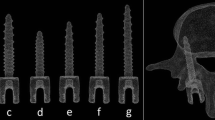Abstract
Based on eight specimens removedfrom fresh cadavers, the morphology of the pedicles of the C3–7cervical vertebrae was determined. Three preliminary designsof pedicle screw and finite element models of the screw withcervical vertebra were developed. The feasibility of pediclescrew fixation for the lower cervical spine is presented.
Similar content being viewed by others
References
K. Abumi, M. M. Panjabi, and J. Duraneau, “Biomehanical evaluation of spinal fixation devices. Part III. Stability provided by six spinal fixation devices and interbody bone graft.” Spine 14(11), pp. 1249–1255, 1989.
R. B. Ashman, R. D. Galpin, and J. D. Corin et al., “Biomehanical analysis of pedicle screw instrumentation systems in a corpectomy model.” Spine 14(12), pp. 1398–1405, 1989.
C. J. Banta, A. G. King, and E. J. Dobezies et al., “Measurement of effective pedicle diameter in the human spine.” Orthopaedics 12, pp. 939–942, 1989.
J. L. Berry, J. M. Moran, and W. S. Berg et al., “A morphometric study of human lumbar and selected thoracic vertebrae.” Spine 12, pp. 362–367, 1987.
Y. Cottrel, J. Dubousset, and M. Guillaumat, “Newuniversal instrumentation in spinal surgery.” Clin. Orthop. 227, pp. 10–23, 1988.
G. J. DeSalvo and R.W. Gorman, ANSYS Engineering Analysis System, User's Manual. Swanson Analysis System, Inc.: Houston, Pa., May, 1989.
D. C. George, M. H. Krag, and C. C. Johnson et al., “Hole preparation techniques for transpedicle screw: Effects on pull-out strength from human cadaveric vertebrae.” Spine 16(2), pp. 181–184, 1991.
V. K. Goel, Y. E. Kim, and T. H. Lim et al., “An analysis investigation of the mechanics of spinal instrumentation.” Spine 13(9), pp. 1003–1011, 1988.
R. Gunzburg and R. D. Fraser, “Stress fracture of the lumbar pedicle, case reports of “pediculolysis” and review of the literature.” Spine 16(2), pp. 185–189, 1991.
M. H. Krag, B. D. Beynnon, and M. H. Pope et al., “Short segments of the thoracic, lumbar, or lumbosacral spine, design and testing.” Clin. Orthop. 203, pp. 75–97, 1986.
M. H. Krag, D. L. Weaver, B. D. Beynnon, and L. D. Haugh, “Morphometry of the thoracic and lumbar spine related to transpedicular screw placement for surgical spinal fixation.” Spine 13(1), pp. 27–32, 1988.
H. Matsuzaki, Y. Tokuhashi, and F. Matsumoto et al., “Problems and solutions of pedicle screw plate fixation of lumbar spine.” Spine 15(11), pp. 1159–1165, 1990.
G. R. Misenhimer, R. D. Peek, and L. L. Willtse et al., “Anatomic analysis of pedicle cortical and cancellous diameter as related to screw size.” Spine 14(4), pp. 368–372, 1989.
P. X. Montesano, E. C. Juach, and P. A. Anderson et al., “Biomechanics of cervical spine internal fixation.” Spine 16(3, suppl.), pp. s10–s16, 1991.
J. M. Moran, W. S. Berg, and J. L. Berry et al., “Transpedicular screw fixation.” J. Orthop. Res. 7(1), pp. 107–114, 1989.
J. M. Olsewski, E. H. Simmons, and F. C. Kallen et al., “Morphometry of the lumbar spine: Anatomical perspectives related to transpedicular fixation.” J. Bone Joint Surg. 72A, pp. 541–549, 1990.
M. M. Panjabi, K. Abumi, and J. Duranceau et al., “Biomechanical evaluation of spinal fixation devices: II. Stability provided by eight internal fixation devices.” Spine 13(10), pp. 1135–1140, 1988.
M. M. Panjabi, K. Abumi, and J. Duranceau et al., “Biomechanical evaluation of spinal fixation devices: II. Stability provided by eight internal fixation devices.” Spine 13(10), pp. 1135–1140, 1988.
M. M. Panjabi, A. A. White, and D. Keller et al., “Stability of the cervical spine under tension.” J. Biomech. 111, pp. 189, 1978.
G. Saillant, “Etude anatonique des pedicles vertebreau, application chirurgicales.” Res Chir Orthop Traumatatol 62, pp. 151–160, 1976.
K. Ueno and Y. K. Liu, “A three-dimensional nonlinear finite element model for lumbar intervertebral joint in torsion.” J. Biomed. Eng. 109, p. 200, Aug. 1987.
N. Zheng, “An investigation of pedicle screw fixation for the lower cervical spine.” MSc thesis, University of Saskatchewan, 1991.
M. R. Zindrick, L. L. Wiltse, and E. H. Widell et al., “Analysis of the morphometric characteristics of the thoracic and lumbar pedicles.” Spine 12, pp. 160–166, 1987.
Author information
Authors and Affiliations
Rights and permissions
About this article
Cite this article
Zheng, N., Yong-Hing, K. & Watson, L.G. Morphological and Biomechanical Studies of Pedicle Screw Fixation for the Lower Cervical Spine. Journal of Systems Integration 10, 55–66 (2000). https://doi.org/10.1023/A:1026559301696
Issue Date:
DOI: https://doi.org/10.1023/A:1026559301696




